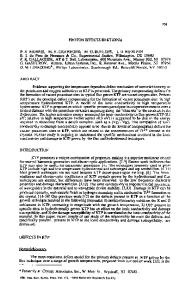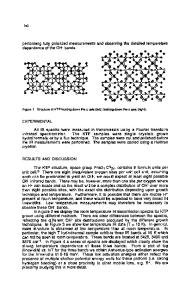Combination of Top-Down and Bottom-Up Approaches Allows Fabrication of High-Aspect-Ratio 2D KTiOPO 4 Photonic Crystals
- PDF / 492,169 Bytes
- 3 Pages / 589.616 x 784.16 pts Page_size
- 24 Downloads / 268 Views
10/31/2006
12:48 PM
Page 852
RESEARCH/RESEARCHERS
which is very close to the experimentally observed characteristic length of 280 nm. Buehler developed a new theoretical framework that provides a quantitative treatment of the nanomechanics of collagen fibrils. Buehler used large-scale computer simulations that begin at the atomistic scale, treating individual chemical interactions based on quantum mechanical calculations to obtain results consistent with his theory. Previous models of collagen typically involved empirical parameters and lacked a rigorous connection between quantum chemistry, molecular structure, material properties and collagen’s physiological function. Buehler’s model provides a first-principles-based materials representation. Furthermore, the model provides a basis for understanding the effects of diseases “caused by defects in the molecular structure of collagen altering the intermolecular and molecular properties due to genetic mutations, which modifies the mechanical behavior of collagen fibrils.” Collagen, an extracellular matrix protein, plays an important role in defining
the infrastructure of physiological tissues under load or strain, and is critical to tissues within the skeletal, muscular, and cardiovascular networks. Improved understanding of nature’s design criteria will help guide materials and biomedical engineers to develop enhanced biomimetic polymers. Buehler’s work could contribute to research that may one day develop cures for collagen-related diseases such as the Ehler–Danlos syndrome, joint hyperextensibility, or scurvy. “We are currently extending our models to describe the deformation mechanics of other structural proteins and more complex materials such as bone,” said Buehler. “For example, the smallest building blocks of bone are mineralized collagen fibrils, which can be modeled using similar concepts.”
Combination of Top-Down and Bottom-Up Approaches Allows Fabrication of High-Aspect-Ratio 2D KTiOPO4 Photonic Crystals In many applications where optoelectronic modulation of light is needed, it would be very useful to have micro- or
nanostructures fabricated from materials with large electro-optic coefficients such as the ones found in many inorganic nonlinear crystals. Unfortunately, when topdown procedures are applied to such materials to produce, for instance, twodimensional (2D) photonic crystals, they are not as effective as when they are applied to semiconductors. A. Peña of the Universitat Rovira i Virgili, S. Di Finizio from the ICFO-Institut de Ciencies Fotoniques, J. Martorell and A. Rodriguez of the Universitat Politecnica de Catalunya, Spain, and their colleagues have obtained 2D photonic crystals by growing microrods of KTiOPO4 inside the air holes of an ordered macroporous silicon membrane closely bound to a KTiOPO4 substrate (see Figure 1). As reported in the September issue of Advanced Materials (DOI: 10.1002/adma. 200502566), the researchers prepared the silicon membranes by computer-controlled light-assisted electrochemical etching of a patterned
Data Loading...











